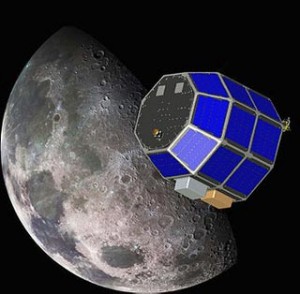NASA selects CU-Boulder to build $6 million lunar dust detector to orbit Moon in 2012

Artist's concept of NASA's Lunar Atmosphere and Dust Experiment Explorer mission, which will carry a $6 million University of Colorado at Boulder instrument known as the Lunar Dust Experiment. (Courtesy NASA)
The University of Colorado at Boulder has been awarded a $6 million grant from NASA to build a high-tech lunar dust detector for a 2011 mission to orbit the moon and conduct science investigations of the dusty lunar surface and its atmosphere.
Known as the Lunar Dust Experiment, or LDEX, the instrument will be designed and built at CU-Boulder’s Laboratory for Atmospheric and Space Physics. The instrument will fly on the Lunar Atmosphere and Dust Experiment Explorer mission, or LADEE, an orbiting satellite that will assess the lunar atmosphere and the nature of dust lofted above the moon’s surface.
The LASP instrument is expected to provide new information on the physical characteristics of lunar dust, from its interactions with the moon’s atmosphere and the solar wind to astronaut safety issues, said LASP Professor Mihály Horányi, principal investigator of LDEX. “We are pleased to have been selected for this exciting mission, and look forward to launch,” said Horányi, also a professor in the physics department.
LADEE will launch in 2011 — before NASA’s moon exploration activities accelerate in the coming decade — and will gather information on lunar surface conditions and environmental influences on lunar dust. The mission should help shape future manned exploration in the lunar environment, according to NASA.
LDEX will be the first instrument to be tested and calibrated for flight by the Colorado Center for Lunar Dust and Atmospheric Studies, or CCLDAS, one of seven initial members of NASA’s Lunar Science Institute announced today. Scientists at the CU-Boulder headquartered CCLDAS, which will be funded by a four-year, $5 million NASA grant, will conduct science and astronaut safety investigations on the lunar surface, said Horányi, also principal investigator on the CCLDAS proposal.
“I find it especially exciting that we not only received funding to build a dust accelerator facility and perform science experiments as part of CCLDAS award, we also will be able to use this facility to test and calibrate space instruments,” said Horányi. “Our own lunar dust detector will be our first customer.”
LADEE is a cooperative effort with NASA Ames Research Center at Moffett Field, Calif., Goddard Space Flight Center in Greenbelt, Md., and Marshall Space Flight Center in Huntsville, Ala. The spacecraft cost is expected to be about $80 million.
